Training Need Analysis Report: Domino's Crisis Communication Strategy
VerifiedAdded on 2022/09/05
|15
|3170
|14
Report
AI Summary
This report presents a training needs analysis (TNA) for Domino's, focusing on crisis communication and social media management in response to a 2009 incident involving employee misconduct. The analysis identifies a critical need for improved crisis communication training, social media presence, and contingency planning. The report examines the identification of performance gaps, the investigation of specific training needs, and the assessment of employee competence. It also outlines training specifications centered around understanding crisis situations, crafting effective messages, choosing appropriate communication channels, and utilizing social media platforms. The report highlights the importance of proactive measures, transparency, and strategic communication to protect the brand's image and maintain customer trust. The analysis emphasizes the need for a robust crisis communication strategy to address potential future challenges and safeguard the company's reputation.
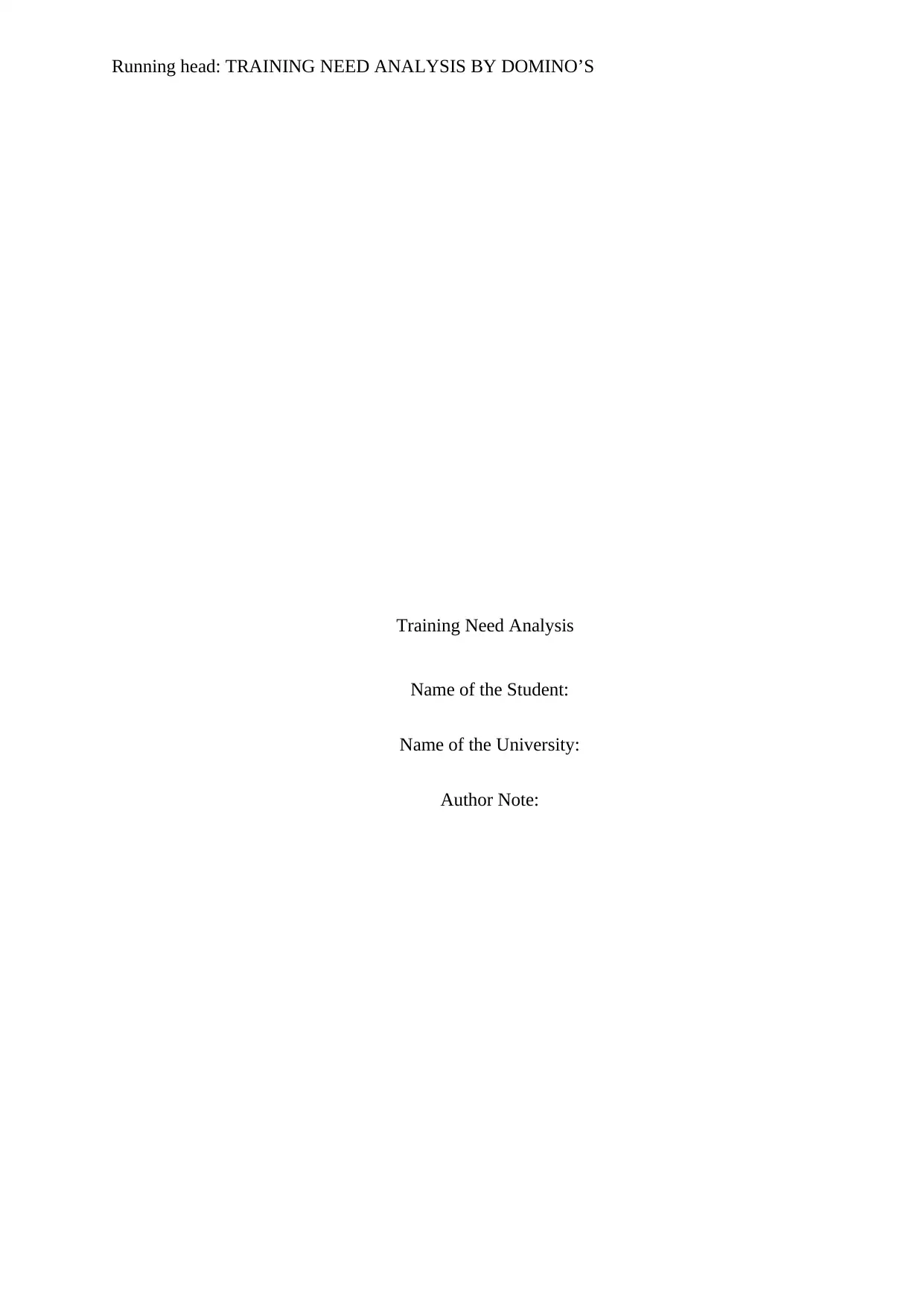
Running head: TRAINING NEED ANALYSIS BY DOMINO’S
Training Need Analysis
Name of the Student:
Name of the University:
Author Note:
Training Need Analysis
Name of the Student:
Name of the University:
Author Note:
Paraphrase This Document
Need a fresh take? Get an instant paraphrase of this document with our AI Paraphraser
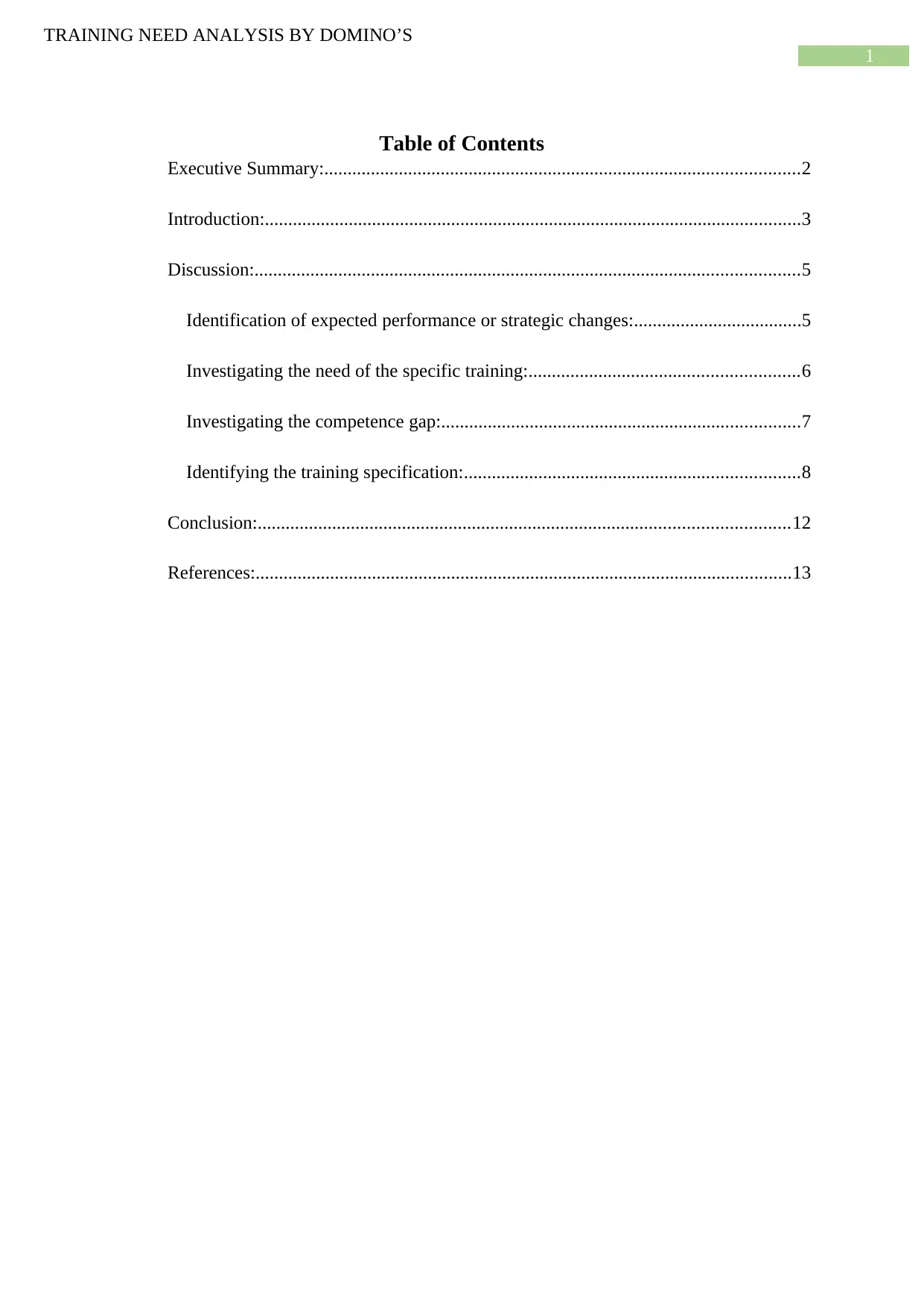
1
TRAINING NEED ANALYSIS BY DOMINO’S
Table of Contents
Executive Summary:......................................................................................................2
Introduction:...................................................................................................................3
Discussion:.....................................................................................................................5
Identification of expected performance or strategic changes:....................................5
Investigating the need of the specific training:..........................................................6
Investigating the competence gap:.............................................................................7
Identifying the training specification:........................................................................8
Conclusion:..................................................................................................................12
References:...................................................................................................................13
TRAINING NEED ANALYSIS BY DOMINO’S
Table of Contents
Executive Summary:......................................................................................................2
Introduction:...................................................................................................................3
Discussion:.....................................................................................................................5
Identification of expected performance or strategic changes:....................................5
Investigating the need of the specific training:..........................................................6
Investigating the competence gap:.............................................................................7
Identifying the training specification:........................................................................8
Conclusion:..................................................................................................................12
References:...................................................................................................................13
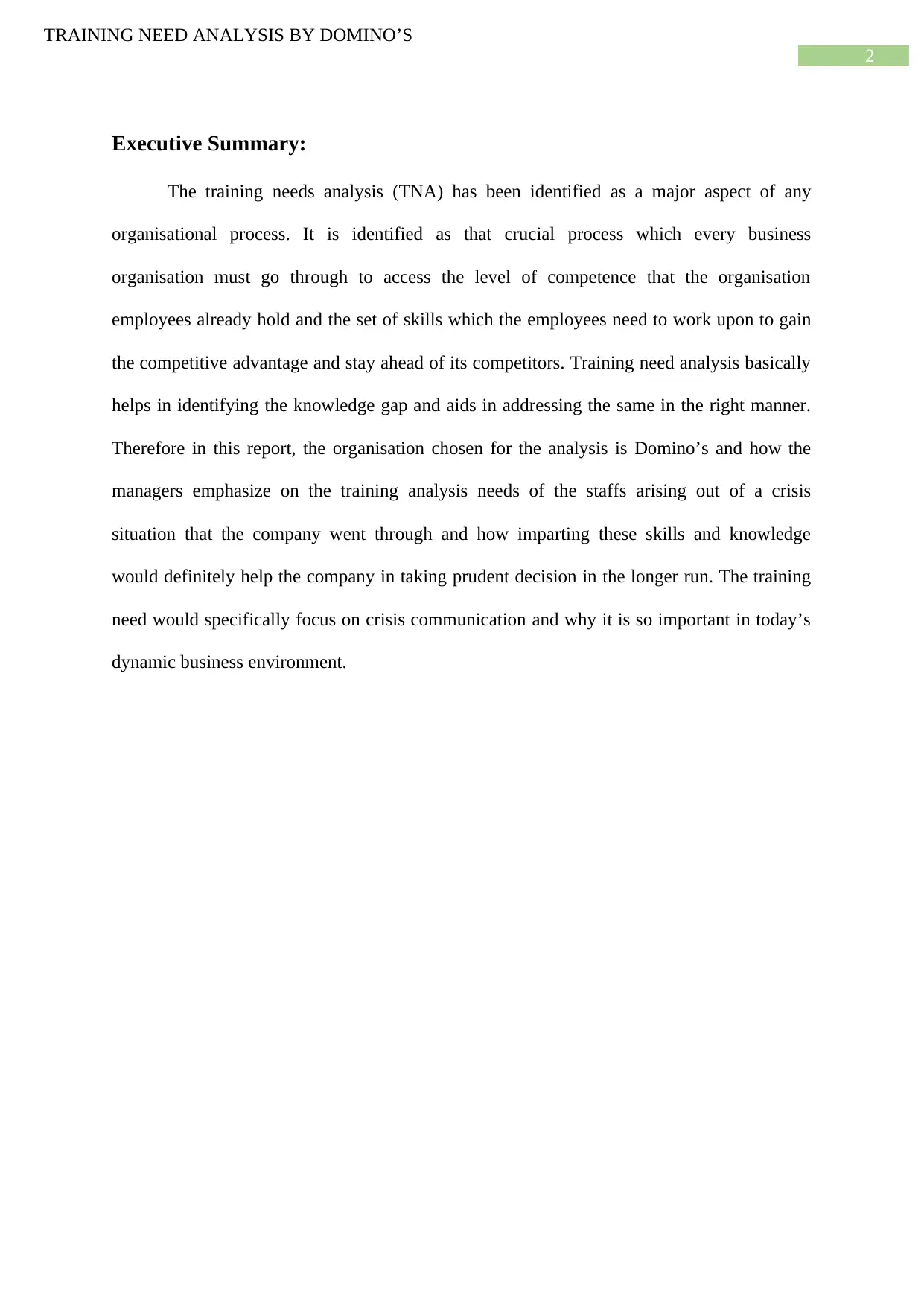
2
TRAINING NEED ANALYSIS BY DOMINO’S
Executive Summary:
The training needs analysis (TNA) has been identified as a major aspect of any
organisational process. It is identified as that crucial process which every business
organisation must go through to access the level of competence that the organisation
employees already hold and the set of skills which the employees need to work upon to gain
the competitive advantage and stay ahead of its competitors. Training need analysis basically
helps in identifying the knowledge gap and aids in addressing the same in the right manner.
Therefore in this report, the organisation chosen for the analysis is Domino’s and how the
managers emphasize on the training analysis needs of the staffs arising out of a crisis
situation that the company went through and how imparting these skills and knowledge
would definitely help the company in taking prudent decision in the longer run. The training
need would specifically focus on crisis communication and why it is so important in today’s
dynamic business environment.
TRAINING NEED ANALYSIS BY DOMINO’S
Executive Summary:
The training needs analysis (TNA) has been identified as a major aspect of any
organisational process. It is identified as that crucial process which every business
organisation must go through to access the level of competence that the organisation
employees already hold and the set of skills which the employees need to work upon to gain
the competitive advantage and stay ahead of its competitors. Training need analysis basically
helps in identifying the knowledge gap and aids in addressing the same in the right manner.
Therefore in this report, the organisation chosen for the analysis is Domino’s and how the
managers emphasize on the training analysis needs of the staffs arising out of a crisis
situation that the company went through and how imparting these skills and knowledge
would definitely help the company in taking prudent decision in the longer run. The training
need would specifically focus on crisis communication and why it is so important in today’s
dynamic business environment.
⊘ This is a preview!⊘
Do you want full access?
Subscribe today to unlock all pages.

Trusted by 1+ million students worldwide
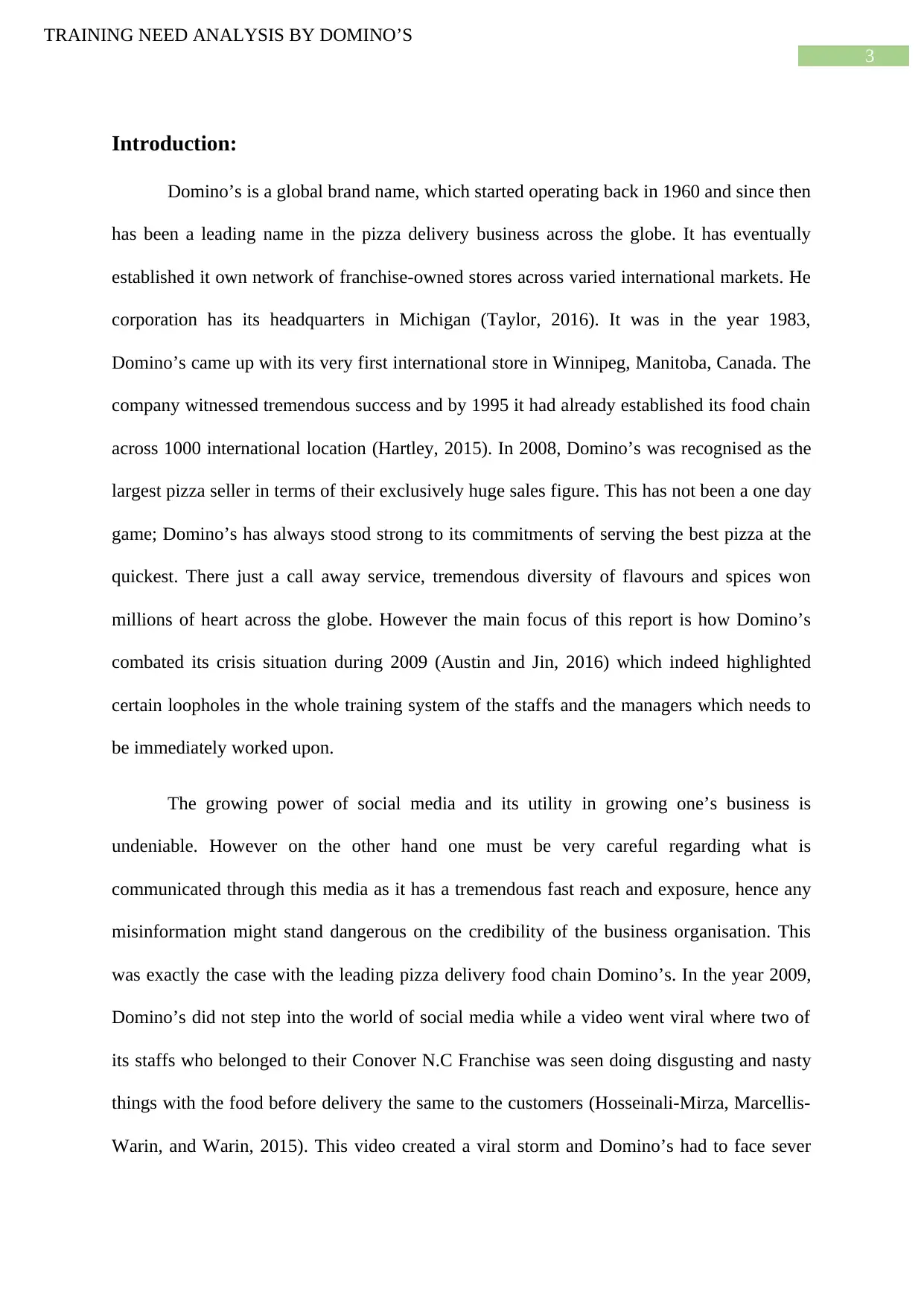
3
TRAINING NEED ANALYSIS BY DOMINO’S
Introduction:
Domino’s is a global brand name, which started operating back in 1960 and since then
has been a leading name in the pizza delivery business across the globe. It has eventually
established it own network of franchise-owned stores across varied international markets. He
corporation has its headquarters in Michigan (Taylor, 2016). It was in the year 1983,
Domino’s came up with its very first international store in Winnipeg, Manitoba, Canada. The
company witnessed tremendous success and by 1995 it had already established its food chain
across 1000 international location (Hartley, 2015). In 2008, Domino’s was recognised as the
largest pizza seller in terms of their exclusively huge sales figure. This has not been a one day
game; Domino’s has always stood strong to its commitments of serving the best pizza at the
quickest. There just a call away service, tremendous diversity of flavours and spices won
millions of heart across the globe. However the main focus of this report is how Domino’s
combated its crisis situation during 2009 (Austin and Jin, 2016) which indeed highlighted
certain loopholes in the whole training system of the staffs and the managers which needs to
be immediately worked upon.
The growing power of social media and its utility in growing one’s business is
undeniable. However on the other hand one must be very careful regarding what is
communicated through this media as it has a tremendous fast reach and exposure, hence any
misinformation might stand dangerous on the credibility of the business organisation. This
was exactly the case with the leading pizza delivery food chain Domino’s. In the year 2009,
Domino’s did not step into the world of social media while a video went viral where two of
its staffs who belonged to their Conover N.C Franchise was seen doing disgusting and nasty
things with the food before delivery the same to the customers (Hosseinali-Mirza, Marcellis-
Warin, and Warin, 2015). This video created a viral storm and Domino’s had to face sever
TRAINING NEED ANALYSIS BY DOMINO’S
Introduction:
Domino’s is a global brand name, which started operating back in 1960 and since then
has been a leading name in the pizza delivery business across the globe. It has eventually
established it own network of franchise-owned stores across varied international markets. He
corporation has its headquarters in Michigan (Taylor, 2016). It was in the year 1983,
Domino’s came up with its very first international store in Winnipeg, Manitoba, Canada. The
company witnessed tremendous success and by 1995 it had already established its food chain
across 1000 international location (Hartley, 2015). In 2008, Domino’s was recognised as the
largest pizza seller in terms of their exclusively huge sales figure. This has not been a one day
game; Domino’s has always stood strong to its commitments of serving the best pizza at the
quickest. There just a call away service, tremendous diversity of flavours and spices won
millions of heart across the globe. However the main focus of this report is how Domino’s
combated its crisis situation during 2009 (Austin and Jin, 2016) which indeed highlighted
certain loopholes in the whole training system of the staffs and the managers which needs to
be immediately worked upon.
The growing power of social media and its utility in growing one’s business is
undeniable. However on the other hand one must be very careful regarding what is
communicated through this media as it has a tremendous fast reach and exposure, hence any
misinformation might stand dangerous on the credibility of the business organisation. This
was exactly the case with the leading pizza delivery food chain Domino’s. In the year 2009,
Domino’s did not step into the world of social media while a video went viral where two of
its staffs who belonged to their Conover N.C Franchise was seen doing disgusting and nasty
things with the food before delivery the same to the customers (Hosseinali-Mirza, Marcellis-
Warin, and Warin, 2015). This video created a viral storm and Domino’s had to face sever
Paraphrase This Document
Need a fresh take? Get an instant paraphrase of this document with our AI Paraphraser
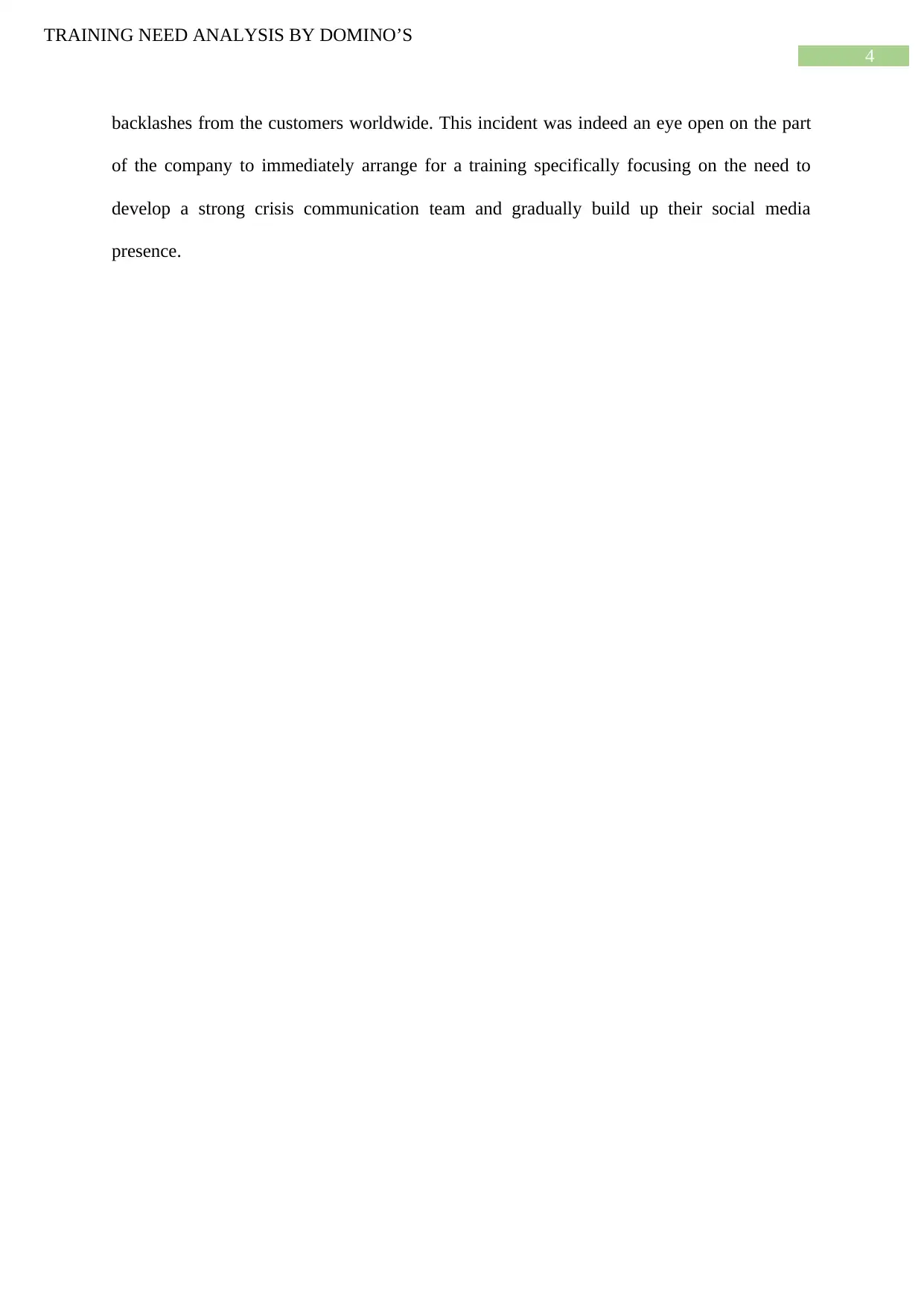
4
TRAINING NEED ANALYSIS BY DOMINO’S
backlashes from the customers worldwide. This incident was indeed an eye open on the part
of the company to immediately arrange for a training specifically focusing on the need to
develop a strong crisis communication team and gradually build up their social media
presence.
TRAINING NEED ANALYSIS BY DOMINO’S
backlashes from the customers worldwide. This incident was indeed an eye open on the part
of the company to immediately arrange for a training specifically focusing on the need to
develop a strong crisis communication team and gradually build up their social media
presence.
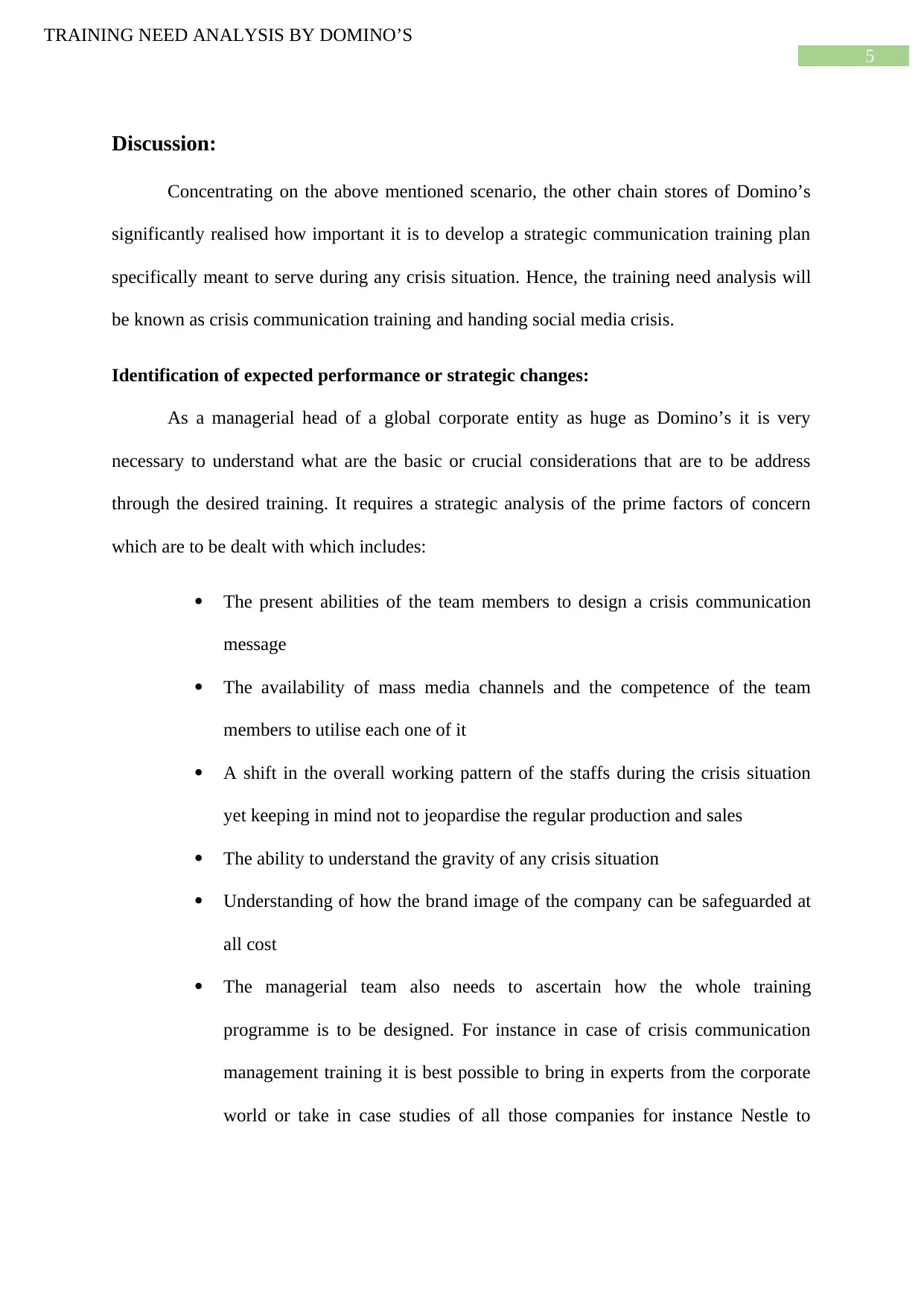
5
TRAINING NEED ANALYSIS BY DOMINO’S
Discussion:
Concentrating on the above mentioned scenario, the other chain stores of Domino’s
significantly realised how important it is to develop a strategic communication training plan
specifically meant to serve during any crisis situation. Hence, the training need analysis will
be known as crisis communication training and handing social media crisis.
Identification of expected performance or strategic changes:
As a managerial head of a global corporate entity as huge as Domino’s it is very
necessary to understand what are the basic or crucial considerations that are to be address
through the desired training. It requires a strategic analysis of the prime factors of concern
which are to be dealt with which includes:
The present abilities of the team members to design a crisis communication
message
The availability of mass media channels and the competence of the team
members to utilise each one of it
A shift in the overall working pattern of the staffs during the crisis situation
yet keeping in mind not to jeopardise the regular production and sales
The ability to understand the gravity of any crisis situation
Understanding of how the brand image of the company can be safeguarded at
all cost
The managerial team also needs to ascertain how the whole training
programme is to be designed. For instance in case of crisis communication
management training it is best possible to bring in experts from the corporate
world or take in case studies of all those companies for instance Nestle to
TRAINING NEED ANALYSIS BY DOMINO’S
Discussion:
Concentrating on the above mentioned scenario, the other chain stores of Domino’s
significantly realised how important it is to develop a strategic communication training plan
specifically meant to serve during any crisis situation. Hence, the training need analysis will
be known as crisis communication training and handing social media crisis.
Identification of expected performance or strategic changes:
As a managerial head of a global corporate entity as huge as Domino’s it is very
necessary to understand what are the basic or crucial considerations that are to be address
through the desired training. It requires a strategic analysis of the prime factors of concern
which are to be dealt with which includes:
The present abilities of the team members to design a crisis communication
message
The availability of mass media channels and the competence of the team
members to utilise each one of it
A shift in the overall working pattern of the staffs during the crisis situation
yet keeping in mind not to jeopardise the regular production and sales
The ability to understand the gravity of any crisis situation
Understanding of how the brand image of the company can be safeguarded at
all cost
The managerial team also needs to ascertain how the whole training
programme is to be designed. For instance in case of crisis communication
management training it is best possible to bring in experts from the corporate
world or take in case studies of all those companies for instance Nestle to
⊘ This is a preview!⊘
Do you want full access?
Subscribe today to unlock all pages.

Trusted by 1+ million students worldwide
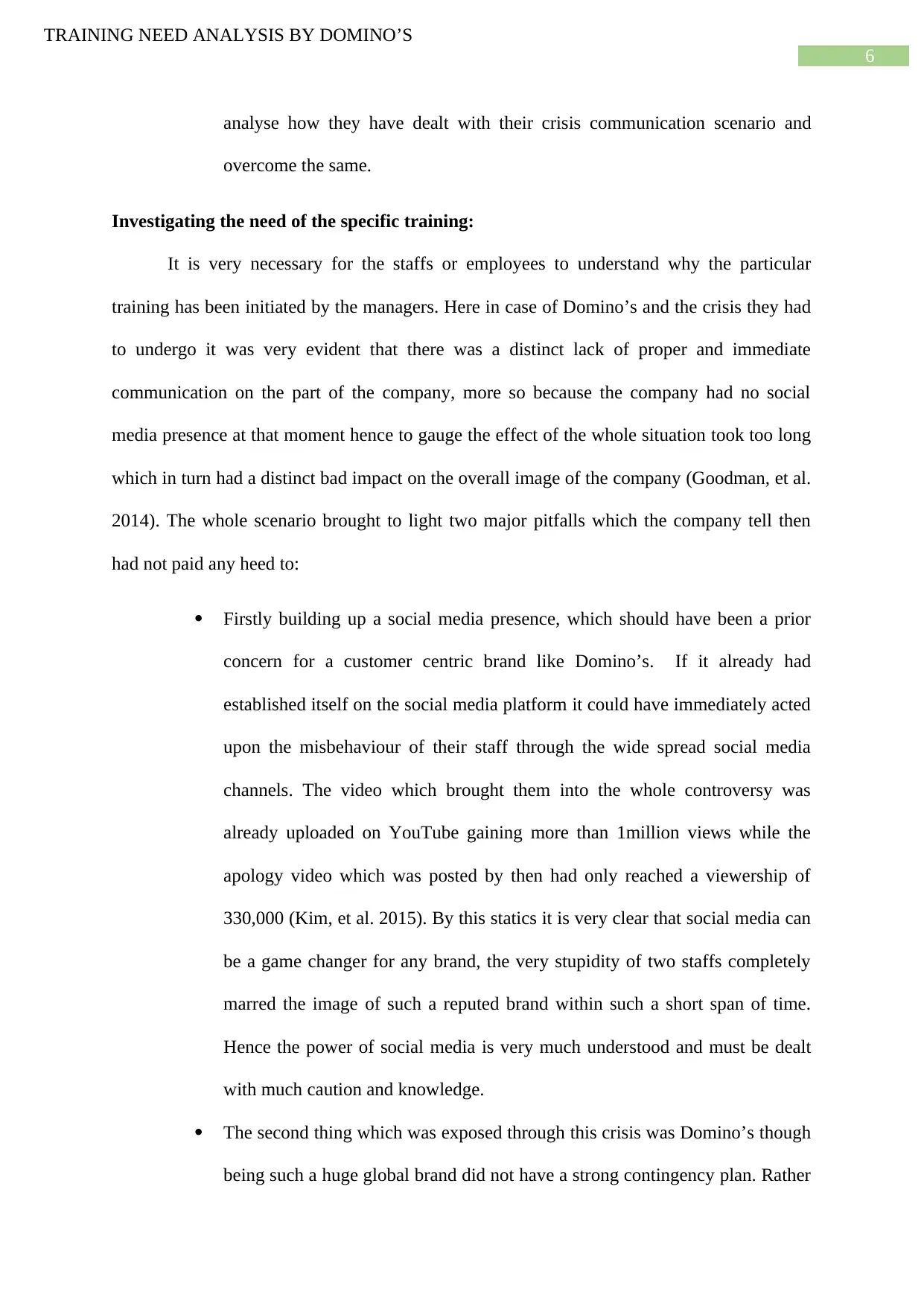
6
TRAINING NEED ANALYSIS BY DOMINO’S
analyse how they have dealt with their crisis communication scenario and
overcome the same.
Investigating the need of the specific training:
It is very necessary for the staffs or employees to understand why the particular
training has been initiated by the managers. Here in case of Domino’s and the crisis they had
to undergo it was very evident that there was a distinct lack of proper and immediate
communication on the part of the company, more so because the company had no social
media presence at that moment hence to gauge the effect of the whole situation took too long
which in turn had a distinct bad impact on the overall image of the company (Goodman, et al.
2014). The whole scenario brought to light two major pitfalls which the company tell then
had not paid any heed to:
Firstly building up a social media presence, which should have been a prior
concern for a customer centric brand like Domino’s. If it already had
established itself on the social media platform it could have immediately acted
upon the misbehaviour of their staff through the wide spread social media
channels. The video which brought them into the whole controversy was
already uploaded on YouTube gaining more than 1million views while the
apology video which was posted by then had only reached a viewership of
330,000 (Kim, et al. 2015). By this statics it is very clear that social media can
be a game changer for any brand, the very stupidity of two staffs completely
marred the image of such a reputed brand within such a short span of time.
Hence the power of social media is very much understood and must be dealt
with much caution and knowledge.
The second thing which was exposed through this crisis was Domino’s though
being such a huge global brand did not have a strong contingency plan. Rather
TRAINING NEED ANALYSIS BY DOMINO’S
analyse how they have dealt with their crisis communication scenario and
overcome the same.
Investigating the need of the specific training:
It is very necessary for the staffs or employees to understand why the particular
training has been initiated by the managers. Here in case of Domino’s and the crisis they had
to undergo it was very evident that there was a distinct lack of proper and immediate
communication on the part of the company, more so because the company had no social
media presence at that moment hence to gauge the effect of the whole situation took too long
which in turn had a distinct bad impact on the overall image of the company (Goodman, et al.
2014). The whole scenario brought to light two major pitfalls which the company tell then
had not paid any heed to:
Firstly building up a social media presence, which should have been a prior
concern for a customer centric brand like Domino’s. If it already had
established itself on the social media platform it could have immediately acted
upon the misbehaviour of their staff through the wide spread social media
channels. The video which brought them into the whole controversy was
already uploaded on YouTube gaining more than 1million views while the
apology video which was posted by then had only reached a viewership of
330,000 (Kim, et al. 2015). By this statics it is very clear that social media can
be a game changer for any brand, the very stupidity of two staffs completely
marred the image of such a reputed brand within such a short span of time.
Hence the power of social media is very much understood and must be dealt
with much caution and knowledge.
The second thing which was exposed through this crisis was Domino’s though
being such a huge global brand did not have a strong contingency plan. Rather
Paraphrase This Document
Need a fresh take? Get an instant paraphrase of this document with our AI Paraphraser
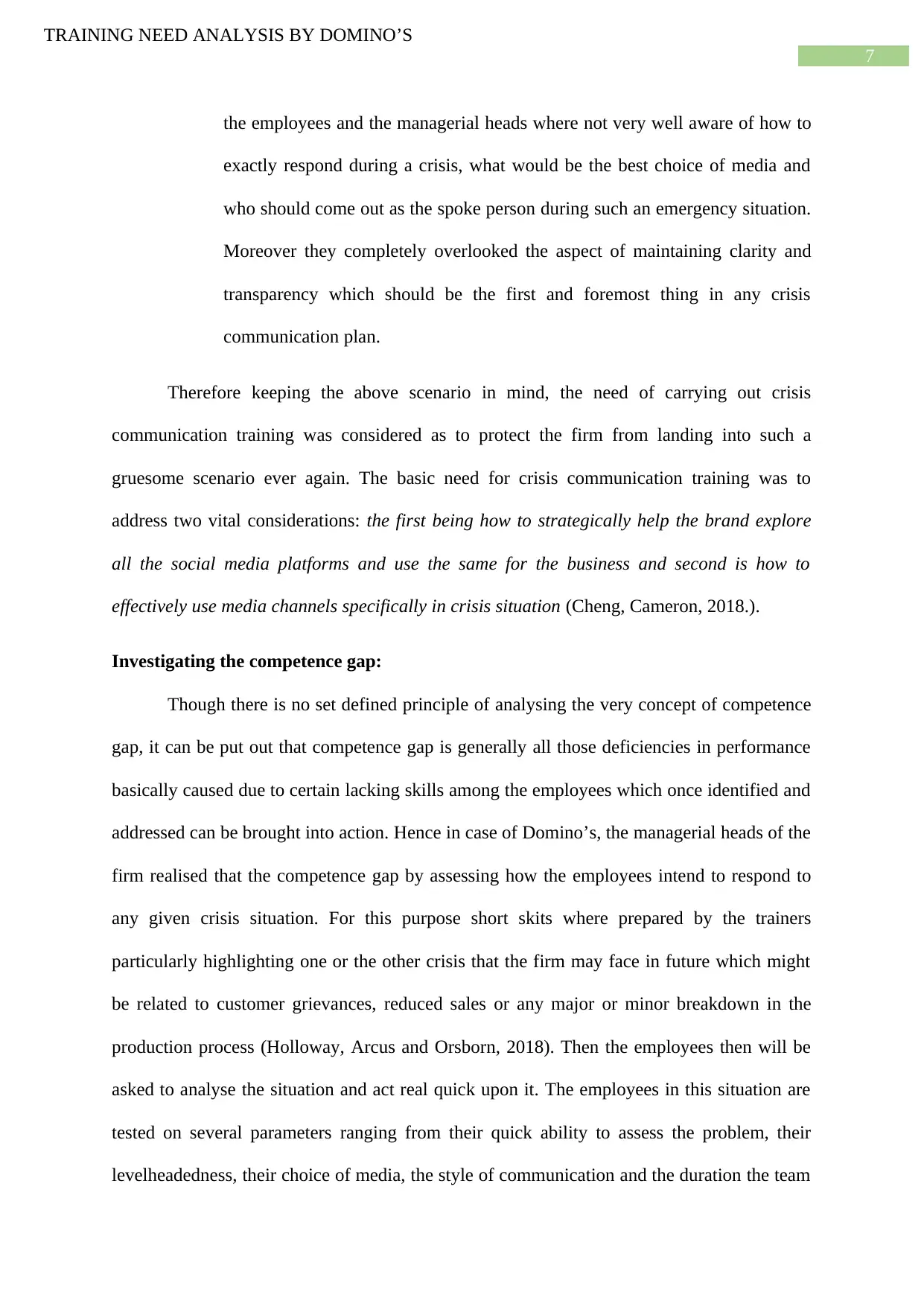
7
TRAINING NEED ANALYSIS BY DOMINO’S
the employees and the managerial heads where not very well aware of how to
exactly respond during a crisis, what would be the best choice of media and
who should come out as the spoke person during such an emergency situation.
Moreover they completely overlooked the aspect of maintaining clarity and
transparency which should be the first and foremost thing in any crisis
communication plan.
Therefore keeping the above scenario in mind, the need of carrying out crisis
communication training was considered as to protect the firm from landing into such a
gruesome scenario ever again. The basic need for crisis communication training was to
address two vital considerations: the first being how to strategically help the brand explore
all the social media platforms and use the same for the business and second is how to
effectively use media channels specifically in crisis situation (Cheng, Cameron, 2018.).
Investigating the competence gap:
Though there is no set defined principle of analysing the very concept of competence
gap, it can be put out that competence gap is generally all those deficiencies in performance
basically caused due to certain lacking skills among the employees which once identified and
addressed can be brought into action. Hence in case of Domino’s, the managerial heads of the
firm realised that the competence gap by assessing how the employees intend to respond to
any given crisis situation. For this purpose short skits where prepared by the trainers
particularly highlighting one or the other crisis that the firm may face in future which might
be related to customer grievances, reduced sales or any major or minor breakdown in the
production process (Holloway, Arcus and Orsborn, 2018). Then the employees then will be
asked to analyse the situation and act real quick upon it. The employees in this situation are
tested on several parameters ranging from their quick ability to assess the problem, their
levelheadedness, their choice of media, the style of communication and the duration the team
TRAINING NEED ANALYSIS BY DOMINO’S
the employees and the managerial heads where not very well aware of how to
exactly respond during a crisis, what would be the best choice of media and
who should come out as the spoke person during such an emergency situation.
Moreover they completely overlooked the aspect of maintaining clarity and
transparency which should be the first and foremost thing in any crisis
communication plan.
Therefore keeping the above scenario in mind, the need of carrying out crisis
communication training was considered as to protect the firm from landing into such a
gruesome scenario ever again. The basic need for crisis communication training was to
address two vital considerations: the first being how to strategically help the brand explore
all the social media platforms and use the same for the business and second is how to
effectively use media channels specifically in crisis situation (Cheng, Cameron, 2018.).
Investigating the competence gap:
Though there is no set defined principle of analysing the very concept of competence
gap, it can be put out that competence gap is generally all those deficiencies in performance
basically caused due to certain lacking skills among the employees which once identified and
addressed can be brought into action. Hence in case of Domino’s, the managerial heads of the
firm realised that the competence gap by assessing how the employees intend to respond to
any given crisis situation. For this purpose short skits where prepared by the trainers
particularly highlighting one or the other crisis that the firm may face in future which might
be related to customer grievances, reduced sales or any major or minor breakdown in the
production process (Holloway, Arcus and Orsborn, 2018). Then the employees then will be
asked to analyse the situation and act real quick upon it. The employees in this situation are
tested on several parameters ranging from their quick ability to assess the problem, their
levelheadedness, their choice of media, the style of communication and the duration the team
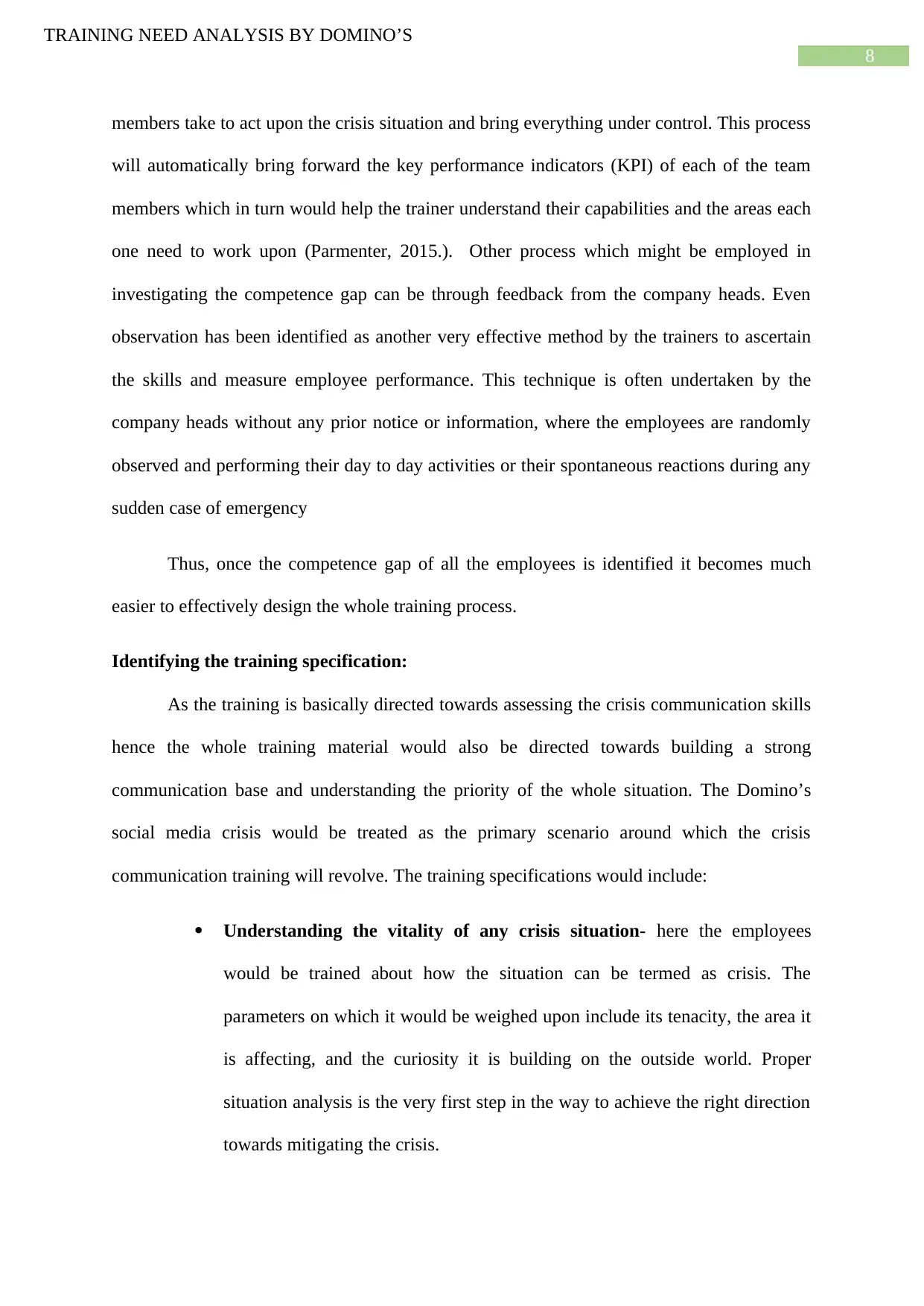
8
TRAINING NEED ANALYSIS BY DOMINO’S
members take to act upon the crisis situation and bring everything under control. This process
will automatically bring forward the key performance indicators (KPI) of each of the team
members which in turn would help the trainer understand their capabilities and the areas each
one need to work upon (Parmenter, 2015.). Other process which might be employed in
investigating the competence gap can be through feedback from the company heads. Even
observation has been identified as another very effective method by the trainers to ascertain
the skills and measure employee performance. This technique is often undertaken by the
company heads without any prior notice or information, where the employees are randomly
observed and performing their day to day activities or their spontaneous reactions during any
sudden case of emergency
Thus, once the competence gap of all the employees is identified it becomes much
easier to effectively design the whole training process.
Identifying the training specification:
As the training is basically directed towards assessing the crisis communication skills
hence the whole training material would also be directed towards building a strong
communication base and understanding the priority of the whole situation. The Domino’s
social media crisis would be treated as the primary scenario around which the crisis
communication training will revolve. The training specifications would include:
Understanding the vitality of any crisis situation- here the employees
would be trained about how the situation can be termed as crisis. The
parameters on which it would be weighed upon include its tenacity, the area it
is affecting, and the curiosity it is building on the outside world. Proper
situation analysis is the very first step in the way to achieve the right direction
towards mitigating the crisis.
TRAINING NEED ANALYSIS BY DOMINO’S
members take to act upon the crisis situation and bring everything under control. This process
will automatically bring forward the key performance indicators (KPI) of each of the team
members which in turn would help the trainer understand their capabilities and the areas each
one need to work upon (Parmenter, 2015.). Other process which might be employed in
investigating the competence gap can be through feedback from the company heads. Even
observation has been identified as another very effective method by the trainers to ascertain
the skills and measure employee performance. This technique is often undertaken by the
company heads without any prior notice or information, where the employees are randomly
observed and performing their day to day activities or their spontaneous reactions during any
sudden case of emergency
Thus, once the competence gap of all the employees is identified it becomes much
easier to effectively design the whole training process.
Identifying the training specification:
As the training is basically directed towards assessing the crisis communication skills
hence the whole training material would also be directed towards building a strong
communication base and understanding the priority of the whole situation. The Domino’s
social media crisis would be treated as the primary scenario around which the crisis
communication training will revolve. The training specifications would include:
Understanding the vitality of any crisis situation- here the employees
would be trained about how the situation can be termed as crisis. The
parameters on which it would be weighed upon include its tenacity, the area it
is affecting, and the curiosity it is building on the outside world. Proper
situation analysis is the very first step in the way to achieve the right direction
towards mitigating the crisis.
⊘ This is a preview!⊘
Do you want full access?
Subscribe today to unlock all pages.

Trusted by 1+ million students worldwide
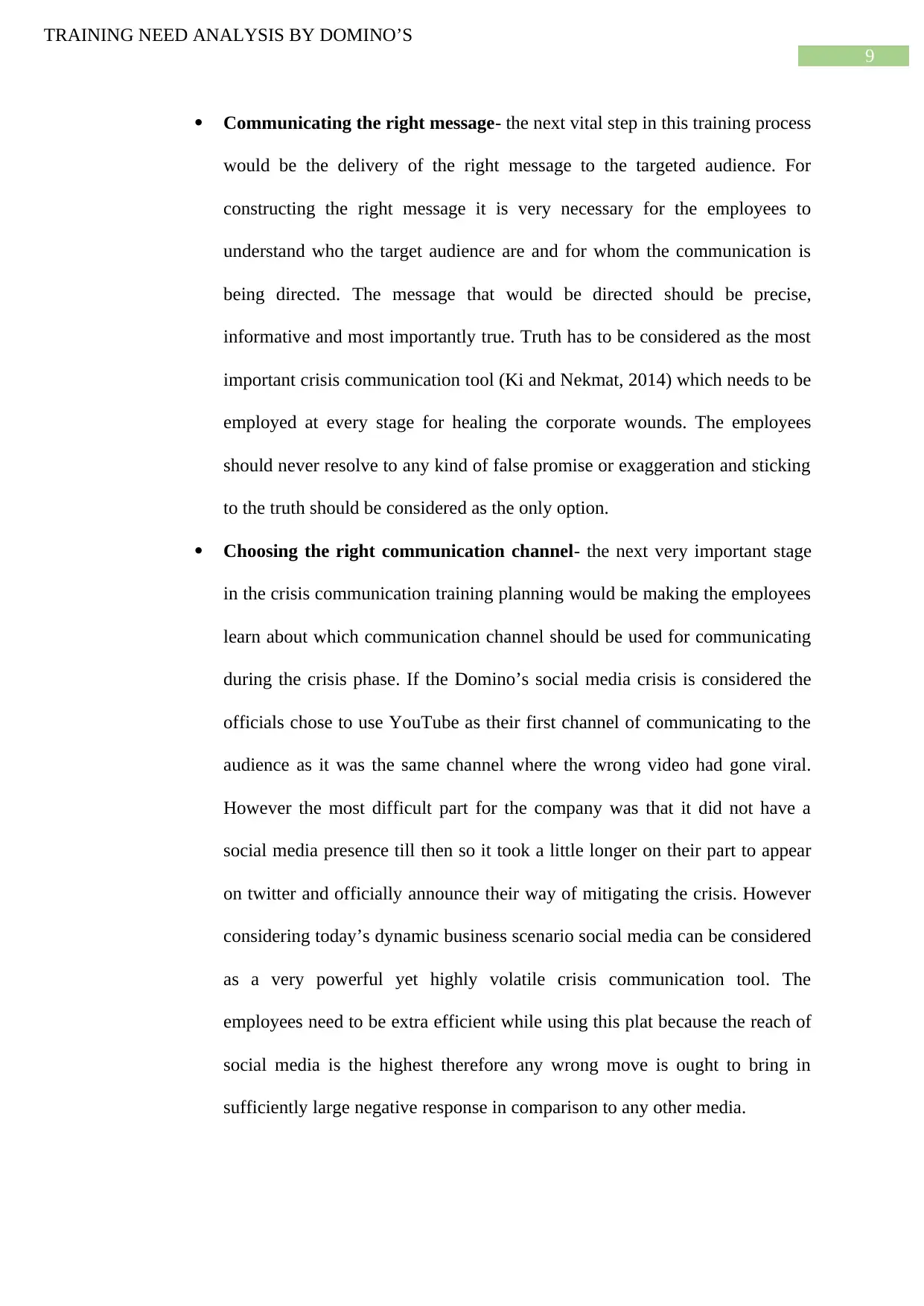
9
TRAINING NEED ANALYSIS BY DOMINO’S
Communicating the right message- the next vital step in this training process
would be the delivery of the right message to the targeted audience. For
constructing the right message it is very necessary for the employees to
understand who the target audience are and for whom the communication is
being directed. The message that would be directed should be precise,
informative and most importantly true. Truth has to be considered as the most
important crisis communication tool (Ki and Nekmat, 2014) which needs to be
employed at every stage for healing the corporate wounds. The employees
should never resolve to any kind of false promise or exaggeration and sticking
to the truth should be considered as the only option.
Choosing the right communication channel- the next very important stage
in the crisis communication training planning would be making the employees
learn about which communication channel should be used for communicating
during the crisis phase. If the Domino’s social media crisis is considered the
officials chose to use YouTube as their first channel of communicating to the
audience as it was the same channel where the wrong video had gone viral.
However the most difficult part for the company was that it did not have a
social media presence till then so it took a little longer on their part to appear
on twitter and officially announce their way of mitigating the crisis. However
considering today’s dynamic business scenario social media can be considered
as a very powerful yet highly volatile crisis communication tool. The
employees need to be extra efficient while using this plat because the reach of
social media is the highest therefore any wrong move is ought to bring in
sufficiently large negative response in comparison to any other media.
TRAINING NEED ANALYSIS BY DOMINO’S
Communicating the right message- the next vital step in this training process
would be the delivery of the right message to the targeted audience. For
constructing the right message it is very necessary for the employees to
understand who the target audience are and for whom the communication is
being directed. The message that would be directed should be precise,
informative and most importantly true. Truth has to be considered as the most
important crisis communication tool (Ki and Nekmat, 2014) which needs to be
employed at every stage for healing the corporate wounds. The employees
should never resolve to any kind of false promise or exaggeration and sticking
to the truth should be considered as the only option.
Choosing the right communication channel- the next very important stage
in the crisis communication training planning would be making the employees
learn about which communication channel should be used for communicating
during the crisis phase. If the Domino’s social media crisis is considered the
officials chose to use YouTube as their first channel of communicating to the
audience as it was the same channel where the wrong video had gone viral.
However the most difficult part for the company was that it did not have a
social media presence till then so it took a little longer on their part to appear
on twitter and officially announce their way of mitigating the crisis. However
considering today’s dynamic business scenario social media can be considered
as a very powerful yet highly volatile crisis communication tool. The
employees need to be extra efficient while using this plat because the reach of
social media is the highest therefore any wrong move is ought to bring in
sufficiently large negative response in comparison to any other media.
Paraphrase This Document
Need a fresh take? Get an instant paraphrase of this document with our AI Paraphraser
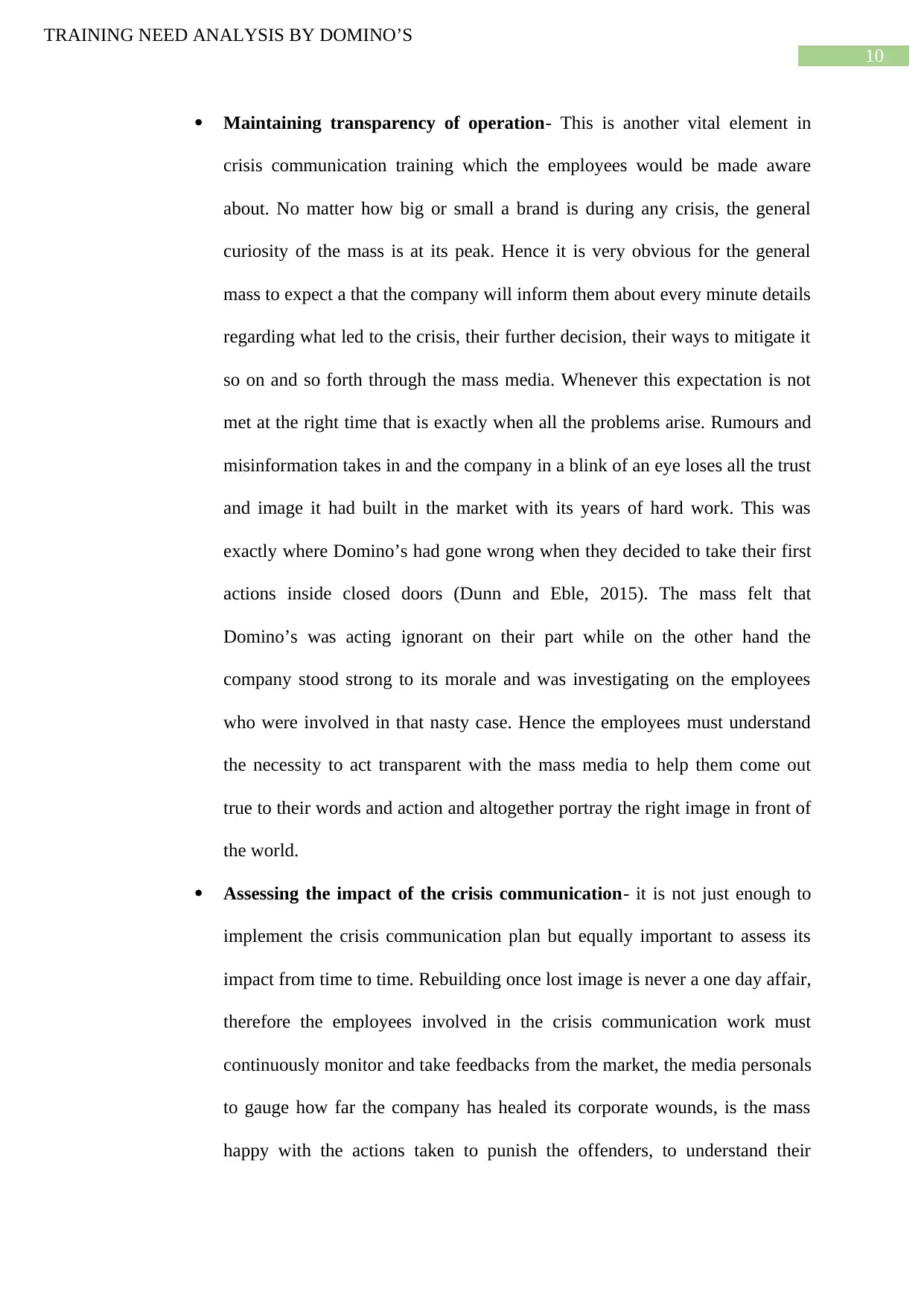
10
TRAINING NEED ANALYSIS BY DOMINO’S
Maintaining transparency of operation- This is another vital element in
crisis communication training which the employees would be made aware
about. No matter how big or small a brand is during any crisis, the general
curiosity of the mass is at its peak. Hence it is very obvious for the general
mass to expect a that the company will inform them about every minute details
regarding what led to the crisis, their further decision, their ways to mitigate it
so on and so forth through the mass media. Whenever this expectation is not
met at the right time that is exactly when all the problems arise. Rumours and
misinformation takes in and the company in a blink of an eye loses all the trust
and image it had built in the market with its years of hard work. This was
exactly where Domino’s had gone wrong when they decided to take their first
actions inside closed doors (Dunn and Eble, 2015). The mass felt that
Domino’s was acting ignorant on their part while on the other hand the
company stood strong to its morale and was investigating on the employees
who were involved in that nasty case. Hence the employees must understand
the necessity to act transparent with the mass media to help them come out
true to their words and action and altogether portray the right image in front of
the world.
Assessing the impact of the crisis communication- it is not just enough to
implement the crisis communication plan but equally important to assess its
impact from time to time. Rebuilding once lost image is never a one day affair,
therefore the employees involved in the crisis communication work must
continuously monitor and take feedbacks from the market, the media personals
to gauge how far the company has healed its corporate wounds, is the mass
happy with the actions taken to punish the offenders, to understand their
TRAINING NEED ANALYSIS BY DOMINO’S
Maintaining transparency of operation- This is another vital element in
crisis communication training which the employees would be made aware
about. No matter how big or small a brand is during any crisis, the general
curiosity of the mass is at its peak. Hence it is very obvious for the general
mass to expect a that the company will inform them about every minute details
regarding what led to the crisis, their further decision, their ways to mitigate it
so on and so forth through the mass media. Whenever this expectation is not
met at the right time that is exactly when all the problems arise. Rumours and
misinformation takes in and the company in a blink of an eye loses all the trust
and image it had built in the market with its years of hard work. This was
exactly where Domino’s had gone wrong when they decided to take their first
actions inside closed doors (Dunn and Eble, 2015). The mass felt that
Domino’s was acting ignorant on their part while on the other hand the
company stood strong to its morale and was investigating on the employees
who were involved in that nasty case. Hence the employees must understand
the necessity to act transparent with the mass media to help them come out
true to their words and action and altogether portray the right image in front of
the world.
Assessing the impact of the crisis communication- it is not just enough to
implement the crisis communication plan but equally important to assess its
impact from time to time. Rebuilding once lost image is never a one day affair,
therefore the employees involved in the crisis communication work must
continuously monitor and take feedbacks from the market, the media personals
to gauge how far the company has healed its corporate wounds, is the mass
happy with the actions taken to punish the offenders, to understand their
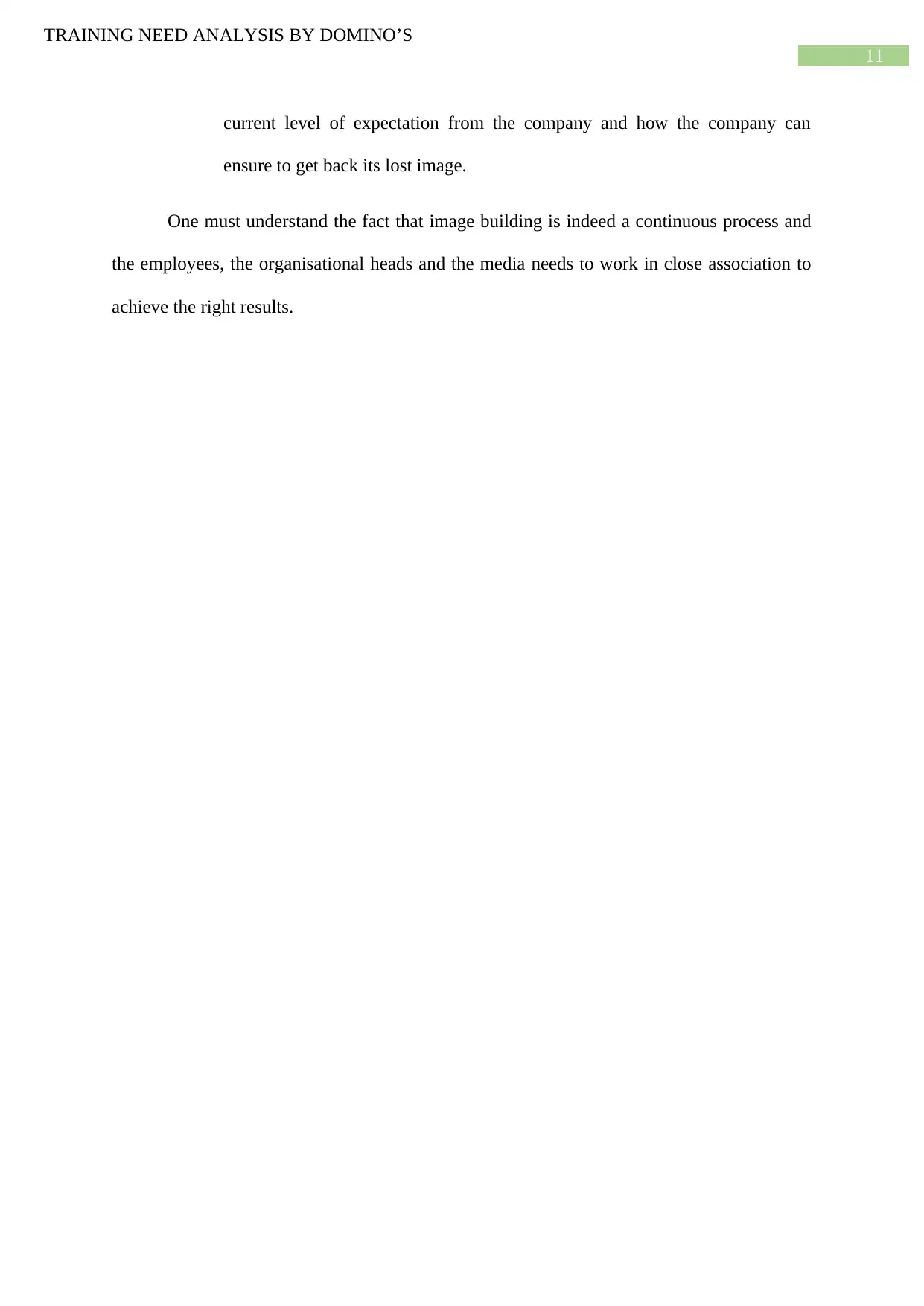
11
TRAINING NEED ANALYSIS BY DOMINO’S
current level of expectation from the company and how the company can
ensure to get back its lost image.
One must understand the fact that image building is indeed a continuous process and
the employees, the organisational heads and the media needs to work in close association to
achieve the right results.
TRAINING NEED ANALYSIS BY DOMINO’S
current level of expectation from the company and how the company can
ensure to get back its lost image.
One must understand the fact that image building is indeed a continuous process and
the employees, the organisational heads and the media needs to work in close association to
achieve the right results.
⊘ This is a preview!⊘
Do you want full access?
Subscribe today to unlock all pages.

Trusted by 1+ million students worldwide
1 out of 15
Related Documents
Your All-in-One AI-Powered Toolkit for Academic Success.
+13062052269
info@desklib.com
Available 24*7 on WhatsApp / Email
![[object Object]](/_next/static/media/star-bottom.7253800d.svg)
Unlock your academic potential
Copyright © 2020–2025 A2Z Services. All Rights Reserved. Developed and managed by ZUCOL.




